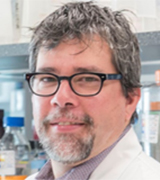Michael Boffa

Scientist
Why I Became a Scientist
I have always been an inquisitive person – as a child I wore out my parents with questions until they broke down and bought a set of encyclopedias. At university, however, I realized I could channel this into a career. As I progressed through my undergraduate biochemistry program, I realized that what most excited me was not the knowledge per se, but the process behind the knowledge. Finding out what we know is great but finding out why we know it is even more so. As I transitioned into graduate school, I took the next step and was thrilled to start generating some new knowledge myself. I also fell in love with the laboratory environment – the intimate intellectual ferment, the camaraderie with lab mates, and the nerd humour. Being able to chase questions that I am passionate about, to learn new scientific stories every day from papers, talks, and Tweets, and to interact with a great group of colleagues and trainees remains an enormous privilege.Research Summary
Protein structure and function, and how learning about it can help people
Each protein is a magnificent molecular machine – more efficient, potent, and elegant than anything dreamt up by the human mind. Evolution has resulted in the fashioning of twenty amino acid building blocks into a dazzling array of proteins of different shapes, sizes, and functions. By peering deeply into their structure at the molecular level, we can learn exactly how they work, why they don’t work in some diseases, and why they work too well in other diseases. In my research, I attempt to leverage this structural and functional information into new approaches to treat or prevent disease.
Research Questions
How is blood clot breakdown regulated?
In this work, I am specifically examining two proteins (TAFI and thrombomodulin) that together control the rate at which blood clots break down. Control of this process is vital, as too much blood clot breakdown can lead to excessive bleeding while too much can lead to inappropriate blood clots (thromboses) that cause heart attacks, strokes, and venous thromboembolism. We are focused on how TAFI activity is generated and how the active enzyme is turned off. Efficient TAFI activation requires a cofactor called thrombomodulin that accelerates snipping of TAFI at one spot by an enzyme called thrombin. We believe that TAFI, thrombin, and thrombomodulin come together as a complex in a specific way to generate TAFI activity. Understanding the molecular details of this interaction could help us devise strategies to either prevent TAFI activation or to enhance it. One unusual property of activated TAFI is that is seems to spontaneously unravel at body temperature after it is formed. This is the mechanism by which the body can limit how much active enzyme is floating around. Examples of inherently unstable proteins like this are exceptionally rare. If we can understand how this unravelling is triggered, we could devise a strategy to prevent that from happening in cases where we would like to prolong TAFI activity, such as hemophilia and cancer metastasis.
Can activation of TAFI prevent cancer metastasis?
Metastasis is the spread of cancer cells from the primary tumour to other parts of the body. Metastasis in fact accounts for the vast majority of deaths from solid tumours, because once the cancer has spread it tends to be more aggressive and resistant to surgical removal or chemotherapy. Despite this, previous attempts to prevent metastasis using drugs targeting this process have failed: the drugs either didn’t work or they were too toxic. My lab is looking at a new approach. It turns out that many of the players that mediate blood clot breakdown also facilitate cancer metastasis. Thus, by provoking TAFI activation in the tumour microenvironment, we could prevent metastasis from even starting. To do this, we are developing a form of thrombomodulin that can specifically support TAFI activation (without the other effects of thrombomodulin getting in the way). We have had promising initial results in a model of breast cancer.
Why are high blood levels of lipoprotein(a) a potent risk factor for cardiovascular disease?
A different molecule that has captured my imagination is lipoprotein(a). This is a protein/fat particle that circulates in the blood and which resembles low density lipoprotein (LDL), which some call the “bad cholesterol”. Lipoprotein(a) differs from LDL by having one extra protein called apo(a), and apo(a) makes all the difference with lipoprotein(a) being many times more dangerous than LDL for heart attacks on a molecule-for-molecule basis. Yet, lipoprotein(a) remains an enigma. Does it play a metabolic role like LDL (which delivers cholesterol to the tissues)? Most people have very low levels of lipoprotein(a), but about 20% of people have levels high enough to put them at increased risk for heart attacks and other cardiovascular diseases. Lipoprotein(a) levels are mostly dictated by genetics, and the usual cholesterol-lowering drugs have little or no effect on it. How does lipoprotein(a) cause disease? It might do some of the same things in the artery wall as LDL, like delivering cholesterol to form plaques. But it is more likely it has unique effects, including promoting inflammation and causing blood clot formation. Together with my close collaborator (and Robarts Scientist) Dr. Marlys Koschinsky, we are busy tackling these questions. We have engineered a large number of apo(a) variants that help as probe the different pathological capabilities of this protein, and we are developing various tools to help us understand how lipoprotein(a) levels are controlled and what damage lipoprotein(a) does in the heart.
Education
- B.Sc., M.Sc., Ph.D. in Biochemistry, Queen’s University
Publications
Contact Info
Michael Boffa
Email: mboffa@uwo.ca








